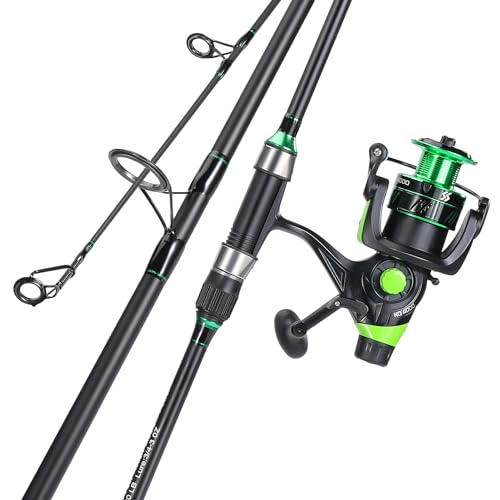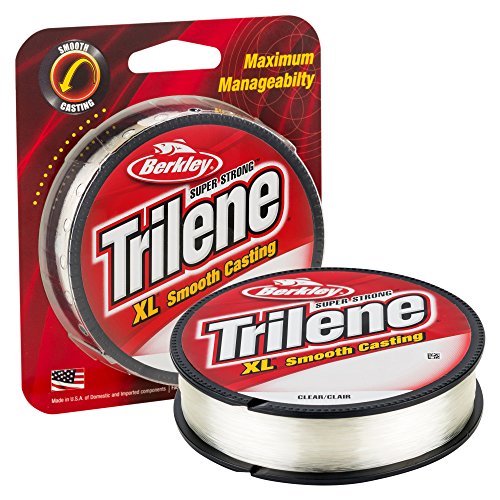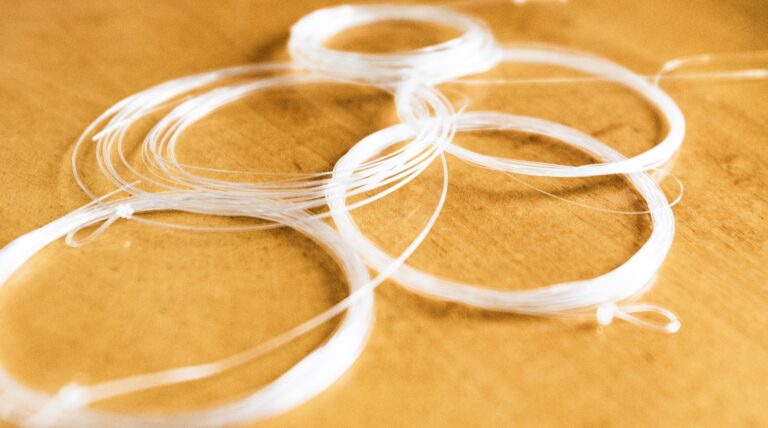A pound test line between 50 and 130 is typically used for tuna fishing. Tuna fishing requires a strong and durable line due to the size and strength of the fish.
It is important to choose a line with a pound test that can handle the weight and resistance when reeling in a tuna. A line with a pound test between 50 and 130 is ideal for most tuna fishing situations.
This range provides the necessary strength to withstand the fight of a tuna while still being manageable for the angler. It is important to consider factors such as the size of the tuna, the fishing technique being used, and the conditions of the water when selecting the appropriate pound test line. By using a suitable pound test line, anglers can increase their chances of successfully landing tuna.

Credit: landedfishing.com
Importance Of Pound Test In Tuna Fishing
Understanding The Pound Test
When it comes to tuna fishing, understanding the pound test is crucial. Pound test refers to the strength of the fishing line, indicating the amount of weight or pressure it can handle before breaking. It plays a vital role in determining the success of your fishing expedition.
Here’s why:
- Pound test is the measurement used to determine the weight of fish that the line can handle. The higher the pound test, the stronger the line, and the larger the fish it can handle.
- It is important to select the right pound test as it directly affects your chances of reeling in a tuna successfully. Using a line with insufficient pound test can result in a snapped line, losing the fish and potentially damaging your equipment.
- The pound test also dictates the fight you can have with the tuna. If you are using a line with a higher pound test, you can exert more pressure to tire out the fish and bring it closer to the boat.
- It is important to note that pound test is not the sole factor in landing a tuna successfully. Factors such as technique, fishing reel, and rod also play significant roles.
How Pound Test Impacts Tuna Fishing
The pound test of your fishing line has a direct impact on your tuna fishing experience. Consider the following aspects:
- Line strength: The pound test determines the overall strength and durability of the line. Tuna are powerful and aggressive fish, putting immense strain on the line during the fight. Opting for a higher pound test provides greater line strength and reduces the risk of breakage.
- Hooking and landing: A line with an appropriate pound test allows you to effectively hook the tuna and bring it to the surface. With a line that is too light, you may struggle to set the hook properly, resulting in missed opportunities. Conversely, a line that is too heavy can inhibit the natural movement of the bait, making it less enticing to the tuna.
- Depth and currents: Tuna often inhabit deep waters and face strong currents. Using a line with a high pound test enables you to handle these challenging conditions, ensuring that you can control the fish and prevent it from escaping.
- Tackle compatibility: Choosing a pound test that matches the capabilities of your fishing rod, reel, and other tackle components is essential. The pound test should be compatible with the rod’s recommended line weight to achieve optimal performance and prevent equipment damages.
Factors To Consider When Selecting A Pound Test
When selecting a pound test for tuna fishing, several factors come into play. Consider the following:
- Target tuna size: Determine the average size of the tuna you are targeting. Larger tuna require lines with a higher pound test, while smaller tuna can be successfully landed with lighter lines.
- Fishing location: Different fishing locations vary in terms of water conditions and the size of tuna present. Research the specific fishing area to understand the average tuna sizes and the challenges you may face. Adjust your pound test accordingly.
- Personal fishing style: Your fishing style and preferences also influence the pound test selection. If you enjoy the challenge of fighting larger tuna, opting for a higher pound test might be suitable. However, if you prefer the thrill of lighter tackle, a lower pound test can be used with caution.
- Line diameter: Consider the diameter of the fishing line as it correlates with the pound test. Thicker lines offer greater strength but may affect casting distance and bait presentation.
- Experience level: Your fishing experience plays a role in determining the appropriate pound test. As a beginner, it may be wise to start with a higher pound test to build confidence and minimize the risk of losing fish.
Remember, selecting the pound test for tuna fishing requires careful consideration of these factors. It is crucial to strike the right balance to enhance your chances of success while enjoying the thrill of the fight with these mighty fish.
Expert Strategies For Choosing Pound Test Line
Tuna fishing requires careful consideration of various factors to ensure a successful catch. One crucial aspect that every angler must carefully evaluate is the pound test line they choose to use. The pound test line refers to the amount of force a fishing line can withstand before it breaks.
Selecting the appropriate pound test line is essential as it directly impacts your ability to reel in a tuna successfully. In this section, we will explore expert strategies for choosing the pound test line for tuna fishing.
Assessing Tuna Species And Size
When it comes to selecting the pound test line for tuna fishing, it is crucial to assess the species and size of tuna you are targeting. Here are some key points to consider:
- Different tuna species vary in size and power, so it is essential to research the specific species you plan to fish for.
- Bluefin tuna, for example, can grow to enormous sizes, requiring a heavier pound test line to handle their strength.
- Yellowfin and blackfin tuna, on the other hand, are generally smaller and may require a lighter pound test line.
- Consider the average size of the tuna in the area you plan to fish. If it is known for larger tuna, opt for a higher pound test line to handle their power.
Fishing Location And Conditions
The fishing location and conditions play a significant role in determining the pound test line you should use. Consider the following factors:
- In offshore fishing scenarios where you may encounter larger tuna and strong currents, it is advisable to use a higher pound test line. This ensures the line can withstand the forces and provides you with the necessary control.
- If you are fishing in calmer waters or closer to shore, where smaller tuna are more common, a lighter pound test line can be suitable.
- Take note of the water clarity and potential obstructions in the area as well. Clearer water may require a lighter line for finicky tuna, while areas with structures or sharp edges may necessitate a stronger line to avoid breakage.
Matching Pound Test With Tuna Fishing Techniques
Lastly, it is crucial to select a pound test line that aligns with your preferred tuna fishing techniques. Consider the following strategies:
- If you enjoy casting and retrieving, a lighter pound test line may be ideal. A lighter line allows for longer casts and offers more sensitivity, enabling you to detect subtle bites.
- For anglers who prefer trolling or live bait fishing, a sturdier pound test line is preferable to handle the larger tuna that are often targeted using these techniques.
- Keep in mind that heavier lines may impact bait presentation and decrease the chances of getting a bite in certain situations. Strike a balance between line strength and bait action to optimize your chances of success.
Remember, selecting the proper pound test line for tuna fishing is a vital component of your overall strategy. By assessing the tuna species and size, fishing location and conditions, and matching the pound test with your preferred techniques, you can enhance your chances of a successful tuna fishing expedition.
Happy fishing!
Success Tips For Using Pound Test Line In Tuna Fishing
Tuna fishing is an exhilarating experience that requires the right gear and techniques to increase your chances of success. Among the many factors to consider, the pound test line plays a crucial role in landing these powerful and speedy fish.
In this section, we will explore some success tips for using pound test line in tuna fishing, focusing on proper knots and leader attachments, handling the tuna fight with the right pound test, and line maintenance and inspection advice.
Proper Knots And Leader Attachments
When it comes to tuna fishing, using the proper knots and leader attachments is essential for ensuring a secure connection between your mainline and leader. Here are some key points to remember:
- Use a strong and reliable knot that can withstand the intense pressure exerted by tuna. Popular choices include the uni knot, improved clinch knot, and palomar knot.
- Consider using a double line or a bimini twist knot to create a stronger connection between your mainline and leader. This will help prevent the line from breaking under the immense strain of a tuna’s powerful pull.
- Utilize a quality swivel or a strong snap swivel to connect your leader to the mainline. This will provide extra strength and flexibility during the fight and decrease the chances of line twist.
Handling Tuna Fight With The Right Pound Test
Using the right pound test line is crucial when encountering tuna, as it determines the line’s strength and ability to withstand the fish’s powerful runs. Here are some tips to keep in mind:
- Choose a pound test line that matches the size and weight of the tuna you are targeting. For smaller tuna species, such as yellowfin or skipjack, a pound test between 30-50 pounds is often sufficient. However, for larger species like bluefin or bigeye tuna, it is recommended to use pound test lines ranging from 80-130 pounds.
- A heavier pound test line will provide more pulling power and increase your chances of landing larger tuna. However, keep in mind that heavier lines may reduce the sensitivity and limit the distance of your casts.
- Maintain steady pressure on the fish while fighting it to prevent it from running and potentially breaking the line. Apply consistent tension without excessive force to tire out the tuna gradually.
Line Maintenance And Inspection Advice
To ensure a successful tuna fishing experience, it is vital to regularly inspect and maintain your pound test line. Here are some essential maintenance tips:
- Before each fishing trip, carefully inspect your line for any signs of wear, fraying, or damage. Also, check the knots and leader attachments to ensure they are secure.
- Clean your line after each use by rinsing it with freshwater to remove any salt or debris that can cause abrasion and weaken the line.
- Avoid storing your line in direct sunlight or extreme temperatures, as this can cause it to degrade over time. Store it in a cool, dry place to prolong its lifespan.
- Regularly check your reel’s drag system to ensure it is functioning correctly. A smooth and well-adjusted drag will aid in fighting and landing tuna more effectively.
By following these success tips for using pound test line in tuna fishing, you’ll be better equipped to handle the challenges of battling these fierce and formidable ocean predators. Remember to choose the right knots and leader attachments, use the appropriate pound test line for the species you’re targeting, and maintain and inspect your line regularly.
With these strategies in place, you’ll increase your chances of a successful tuna fishing adventure.
Conclusion
To summarize, choosing the right pound test line for tuna fishing is crucial for a successful and enjoyable fishing experience. Understanding the factors such as the size of the tuna, the fishing location, and the fishing technique will help you make an informed decision.
Remember that heavier pound test lines are suitable for larger tuna species, while lighter lines are better for smaller tuna. Depending on the circumstances, a range between 20-80 pound test line will cover most tuna fishing situations. It’s also important to consider the line’s strength, abrasion resistance, and flexibility.
Ultimately, finding the perfect pound test line involves experimentation and adapting to different fishing conditions. By following these guidelines, you will increase your chances of landing those prized tuna and making unforgettable memories on the water. So, get your gear ready, choose wisely, and enjoy the thrilling adventure of tuna fishing!




